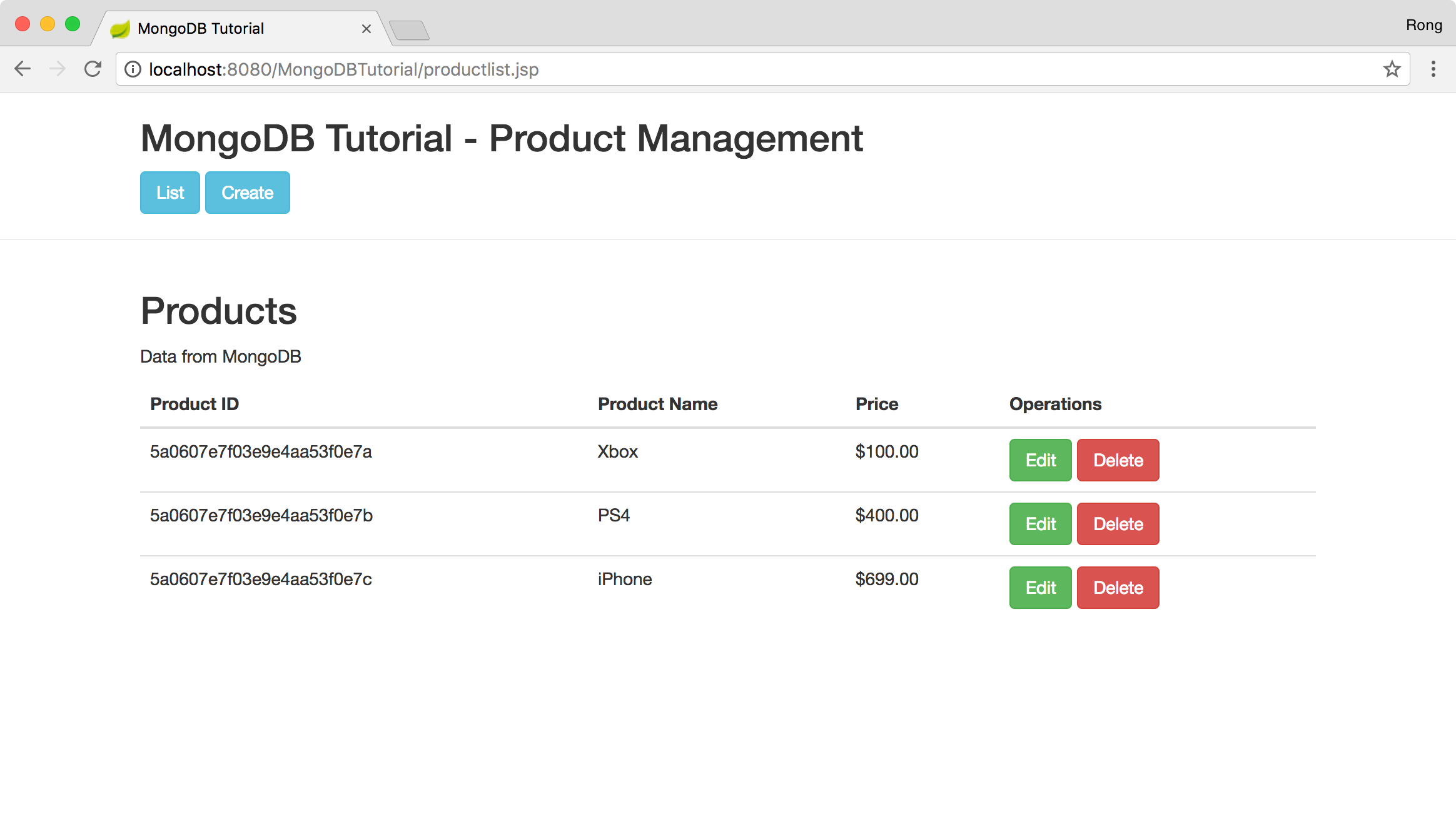2533. Building Website with JSP and MongoDBJSP, MongoDB, and Maven
Build a web application with Java Server Pages (JSP) and MongoDB.
1. Prerequisites
1.1 Java Development Environment
Development environment has been setup. JDK, Eclipse and Tomcat are all installed. Otherwise, refer to Setting up Java Development Environment on Mac to setup your development environment.
1.2 MongoDB
MongoDB database has been installed. Otherwise, refer to Installing MongoDB on Ubuntu and Mac to install MongoDB.
2. Setting up JSP Project
2.1 Creating Dynamic Web Project
In Eclipse, File->New->Dynamic Web Project, specify project name as ‘MongoDBTutorial’. Then, right click project MongoDBTutorial -> Configure -> Convert to Maven Project.

2.2 Adding Libraries to the Project
1) JSTL
Go to https://tomcat.apache.org/taglibs/index.html, download JSP Standard Tag Library(JSTL). Put the jar file to \WebContent\WEB-INF\lib.
2) MongoDB Java Driver
To let our JSP application access MongoDB database, we need MongoDB Driver. It is a bridge between our JSP application and MongoDB Database. Go to https://mongodb.github.io/mongo-java-driver/, download mongodb driver, eg. ‘mongodb-driver-3.1.1.jar’, put it to \WebContent\WEB-INF\lib.
2.3 Creating web.xml
Create a file named web.xml in \WebContent\WEB-INF with following content. Notice, we set the ‘MONGODB_HOST’ and ‘MONGODB_PORT’.
<?xml version="1.0" encoding="UTF-8"?>
<web-app version="3.1" xmlns="http://xmlns.jcp.org/xml/ns/javaee" xmlns:xsi="http://www.w3.org/2001/XMLSchema-instance" xsi:schemaLocation="http://xmlns.jcp.org/xml/ns/javaee http://xmlns.jcp.org/xml/ns/javaee/web-app_3_1.xsd">
<display-name>MongoDB Tutorial</display-name>
<context-param>
<param-name>MONGODB_HOST</param-name>
<param-value>localhost</param-value>
</context-param>
<context-param>
<param-name>MONGODB_PORT</param-name>
<param-value>27017</param-value>
</context-param>
<welcome-file-list>
<welcome-file>productlist.jsp</welcome-file>
</welcome-file-list>
<session-config>
<session-timeout>
30
</session-timeout>
</session-config>
</web-app>
2.4 Adding Dependencies in pom.xml
Edit pom.xml, add dependencies for MongoDB and JSTL.
<dependencies>
<!-- MongoDB Java Driver -->
<dependency>
<groupId>org.mongodb</groupId>
<artifactId>mongo-java-driver</artifactId>
<version>3.1.1</version>
</dependency>
<!-- JSTL libraries for JSP pages -->
<dependency>
<groupId>jstl</groupId>
<artifactId>jstl</artifactId>
<version>1.2</version>
</dependency>
<dependency>
<groupId>taglibs</groupId>
<artifactId>standard</artifactId>
<version>1.1.2</version>
</dependency>
</dependencies>
2.5 Creating Java Files
Right-click on MongoDBTutorial->Java Resources->src, create package named johnny.mongodbtutorial.model. Then, create java file named Product.java with the following content.
package johnny.mongodbtutorial.model;
public class Product {
private String id;
private String name;
private double price;
public Product() {}
public Product(String id, String name, double price) {
this.id = id;
this.name = name;
this.price = price;
}
public String getId() {
return id;
}
public void setId(String id) {
this.id = id;
}
public String getName() {
return name;
}
public void setName(String name) {
this.name = name;
}
public double getPrice() {
return price;
}
public void setPrice(double price) {
this.price = price;
}
}
Create package named johnny.mongodbtutorial.converter. Then, create java file named ProductConverter.java with the following content.
package johnny.mongodbtutorial.converter;
import org.bson.Document;
import org.bson.types.ObjectId;
import johnny.mongodbtutorial.model.Product;
public class ProductConverter {
// convert Product Object to MongoDB Document
// take special note of converting id String to ObjectId
public static Document toDocument(Product p) {
Document doc = new Document("name", p.getName()).append("price", p.getPrice());
if (p.getId() != null) {
doc.append("_id", new ObjectId(p.getId()));
}
return doc;
}
// convert MongoDB Document to Product
// take special note of converting ObjectId to String
public static Product toProduct(Document doc) {
Product p = new Product();
p.setName((String) doc.get("name"));
p.setPrice((Double) doc.get("price"));
p.setId(((ObjectId) doc.get("_id")).toString());
return p;
}
}
Create package named johnny.mongodbtutorial.dao. Then, create java file named ProductDao.java with the following methods for CRUD operations.
- create()
- update()
- delete()
- exists()
- getList()
- getProduct()
package johnny.mongodbtutorial.dao;
import java.util.ArrayList;
import java.util.List;
import org.bson.Document;
import org.bson.types.ObjectId;
import com.mongodb.MongoClient;
import com.mongodb.client.FindIterable;
import com.mongodb.client.MongoCollection;
import com.mongodb.client.MongoCursor;
import com.mongodb.client.model.Filters;
import johnny.mongodbtutorial.converter.ProductConverter;
import johnny.mongodbtutorial.model.Product;
public class ProductDao {
private MongoCollection<Document> coll;
public ProductDao(MongoClient mongo) {
this.coll = mongo.getDatabase("mongodbtutorial").getCollection("product");
}
public Product create(Product p) {
Document doc = ProductConverter.toDocument(p);
this.coll.insertOne(doc);
ObjectId id = (ObjectId) doc.get("_id");
p.setId(id.toString());
return p;
}
public void update(Product p) {
this.coll.updateOne(Filters.eq("_id", new ObjectId(p.getId())), new Document("$set", ProductConverter.toDocument(p)));
}
public void delete(String id) {
this.coll.deleteOne(Filters.eq("_id", new ObjectId(id)));
}
public boolean exists(String id) {
FindIterable<Document> doc = this.coll.find(Filters.eq("_id", id)).limit(1);
return doc != null;
}
public List<Product> getList() {
List<Product> list = new ArrayList<Product>();
MongoCursor<Document> cursor = coll.find().iterator();
try {
while (cursor.hasNext()) {
Document doc = cursor.next();
Product p = ProductConverter.toProduct(doc);
list.add(p);
}
} finally {
cursor.close();
}
return list;
}
public Product getProduct(String id) {
Document doc = this.coll.find(Filters.eq("_id", new ObjectId(id))).first();
return ProductConverter.toProduct(doc);
}
}
Create package named johnny.mongodbtutorial.listener. Then, create java file named MongoDBContextListener.java with following content.
package johnny.mongodbtutorial.listener;
import javax.servlet.ServletContext;
import javax.servlet.ServletContextEvent;
import javax.servlet.ServletContextListener;
import javax.servlet.annotation.WebListener;
import com.mongodb.MongoClient;
import com.mongodb.MongoException;
@WebListener
public class MongoDBContextListener implements ServletContextListener {
@Override
public void contextInitialized(ServletContextEvent sce) {
try {
ServletContext ctx = sce.getServletContext();
MongoClient mongo = new MongoClient(
ctx.getInitParameter("MONGODB_HOST"),
Integer.parseInt(ctx.getInitParameter("MONGODB_PORT")));
System.out.println("MongoClient initialized successfully");
sce.getServletContext().setAttribute("MONGO_CLIENT", mongo);
} catch (MongoException e) {
throw new RuntimeException("MongoClient init failed");
}
}
@Override
public void contextDestroyed(ServletContextEvent sce) {
MongoClient mongo = (MongoClient) sce.getServletContext()
.getAttribute("MONGO_CLIENT");
mongo.close();
System.out.println("MongoClient closed successfully");
}
}
3.6 Creating JSP Files
In Project Explorer, right-click on MongoDBTutorial->WebContent, New->JSP File. Specify file name header.jsp and add following content into it.
<div class="container">
<h2>MongoDB Tutorial - Product Management</h2>
<a class="btn btn-info" href="productlist.jsp">List</a>
<a class="btn btn-info" href="productadd.jsp">Create</a>
</div>
<hr/>
Create another JSP file named productlist.jsp with following content.
<%@ page language="java" contentType="text/html; charset=UTF-8"
pageEncoding="UTF-8"%>
<!DOCTYPE html PUBLIC "-//W3C//DTD HTML 4.01 Transitional//EN" "http://www.w3.org/TR/html4/loose.dtd">
<%@page import="johnny.mongodbtutorial.model.Product"%>
<%@page import="johnny.mongodbtutorial.dao.ProductDao"%>
<%@page import="java.util.List"%>
<%@page import="com.mongodb.MongoClient"%>
<%@ taglib prefix="c" uri="http://java.sun.com/jsp/jstl/core" %>
<%@ taglib prefix="fmt" uri="http://java.sun.com/jsp/jstl/fmt" %>
<%
String errmsg = "";
MongoClient mongo = (MongoClient) request.getServletContext()
.getAttribute("MONGO_CLIENT");
ProductDao productDao = new ProductDao(mongo);
List<Product> products = productDao.getList();
if (products == null || products.size() == 0) {
errmsg = "There is no product!";
}
pageContext.setAttribute("errmsg", errmsg);
pageContext.setAttribute("products", products);
%>
<html>
<head>
<meta http-equiv="Content-Type" content="text/html; charset=UTF-8">
<title>MongoDB Tutorial</title>
<meta name="viewport" content="width=device-width, initial-scale=1">
<link rel="stylesheet" href="https://maxcdn.bootstrapcdn.com/bootstrap/3.3.7/css/bootstrap.min.css">
<script src="https://ajax.googleapis.com/ajax/libs/jquery/3.2.1/jquery.min.js"></script>
<script src="https://maxcdn.bootstrapcdn.com/bootstrap/3.3.7/js/bootstrap.min.js"></script>
</head>
<body>
<jsp:include page="header.jsp" />
<div class="container">
<h2>Products</h2>
<p>Data from MongoDB</p>
<table class="table">
<thead>
<tr>
<th>Product ID</th>
<th>Product Name</th>
<th>Price</th>
<th>Operations</th>
</tr>
</thead>
<tbody>
<c:choose>
<c:when test="${not empty errmsg}">
<tr style='color:red'><td>${errmsg}</td></tr>
</c:when>
<c:otherwise>
<c:forEach var="product" items="${products}">
<tr>
<td><c:out value="${product.id}"/></td>
<td><c:out value="${product.name}"/></td>
<td><fmt:setLocale value="en_US"/><fmt:formatNumber value="${product.price}" type="currency"/></td>
<td><a class="btn btn-success" href="productedit.jsp?id=${product.id}">Edit</a> <a class="btn btn-danger" href="productdel.jsp?id=${product.id}" onclick="return confirm('Are you sure to delete this product?')">Delete</a></td>
</tr>
</c:forEach>
</c:otherwise>
</c:choose>
</tbody>
</table>
</div>
</body>
</html>
Create another JSP file named productadd.jsp with following content.
<%@ page language="java" contentType="text/html; charset=UTF-8"
pageEncoding="UTF-8"%>
<!DOCTYPE html PUBLIC "-//W3C//DTD HTML 4.01 Transitional//EN" "http://www.w3.org/TR/html4/loose.dtd">
<%@page import="johnny.mongodbtutorial.model.Product"%>
<%@page import="johnny.mongodbtutorial.dao.ProductDao"%>
<%@page import="java.util.List"%>
<%@page import="com.mongodb.MongoClient"%>
<%@ taglib prefix="c" uri="http://java.sun.com/jsp/jstl/core" %>
<%@ taglib prefix="fmt" uri="http://java.sun.com/jsp/jstl/fmt" %>
<%
String errmsg = "";
String name = "";
String price = "";
if ("GET".equalsIgnoreCase(request.getMethod())) {
} else {
name = request.getParameter("name");
price = request.getParameter("price");
if(name == null || name.isEmpty()){
errmsg = "Product name can't be empty!";
}else if(price == null || price.isEmpty()){
errmsg = "Price can't be empty!";
}
double dprice = 0.0;
if (errmsg.isEmpty()) {
try {
dprice = Double.parseDouble(price);
Product product = new Product();
product.setName(name);
product.setPrice(dprice);
// create
MongoClient mongo = (MongoClient) request.getServletContext()
.getAttribute("MONGO_CLIENT");
ProductDao productDao = new ProductDao(mongo);
productDao.create(product);
response.sendRedirect("productlist.jsp");
} catch (NumberFormatException nfe) {
errmsg = "Price must be number!";
}
}
}
pageContext.setAttribute("errmsg", errmsg);
pageContext.setAttribute("name", name);
pageContext.setAttribute("price", price);
%>
<html>
<head>
<meta http-equiv="Content-Type" content="text/html; charset=UTF-8">
<title>MongoDB Tutorial</title>
<meta name="viewport" content="width=device-width, initial-scale=1">
<link rel="stylesheet" href="https://maxcdn.bootstrapcdn.com/bootstrap/3.3.7/css/bootstrap.min.css">
<script src="https://ajax.googleapis.com/ajax/libs/jquery/3.2.1/jquery.min.js"></script>
<script src="https://maxcdn.bootstrapcdn.com/bootstrap/3.3.7/js/bootstrap.min.js"></script>
</head>
<body>
<jsp:include page="header.jsp" />
<div class="container">
<h2>Add New Product</h2>
<h3 style='color:red'>${errmsg}</h3>
<form class="form-horizontal" action="productadd.jsp" method="Post">
<div class="form-group">
<label class="control-label col-sm-2" for="email">Product Name:</label>
<div class="col-sm-10">
<input class="form-control" id="name" placeholder="Enter product name" name="name" value="${name}">
</div>
</div>
<div class="form-group">
<label class="control-label col-sm-2" for="pwd">Price:</label>
<div class="col-sm-10">
<input class="form-control" id="price" placeholder="Enter price" name="price" value="${price}">
</div>
</div>
<div class="form-group">
<div class="col-sm-offset-2 col-sm-10">
<button type="submit" class="btn btn-primary">Save</button>
</div>
</div>
</form>
</div>
</body>
</html>
Create another JSP file named productedit.jsp with following content.
<%@ page language="java" contentType="text/html; charset=UTF-8"
pageEncoding="UTF-8"%>
<!DOCTYPE html PUBLIC "-//W3C//DTD HTML 4.01 Transitional//EN" "http://www.w3.org/TR/html4/loose.dtd">
<%@page import="johnny.mongodbtutorial.model.Product"%>
<%@page import="johnny.mongodbtutorial.dao.ProductDao"%>
<%@page import="java.util.List"%>
<%@page import="com.mongodb.MongoClient"%>
<%@ taglib prefix="c" uri="http://java.sun.com/jsp/jstl/core" %>
<%@ taglib prefix="fmt" uri="http://java.sun.com/jsp/jstl/fmt" %>
<%
String id = request.getParameter("id");
String errmsg = "";
String name = "";
String price = "";
if (id == null || id.isEmpty()) {
errmsg = "Invalid parameter!";
} else {
MongoClient mongo = (MongoClient) request.getServletContext()
.getAttribute("MONGO_CLIENT");
ProductDao productDao = new ProductDao(mongo);
if ("GET".equalsIgnoreCase(request.getMethod())) {
Product product = productDao.getProduct(id);
name = product.getName();
price = Double.toString(product.getPrice());
} else {
name = request.getParameter("name");
price = request.getParameter("price");
if(name == null || name.isEmpty()){
errmsg = "Product name can't be empty!";
}else if(price == null || price.isEmpty()){
errmsg = "Price can't be empty!";
}
double dprice = 0.0;
if (errmsg.isEmpty()) {
try {
dprice = Double.parseDouble(price);
} catch (NumberFormatException nfe) {
errmsg = "Price must be number!";
}
Product product = productDao.getProduct(id);
product.setName(name);
product.setPrice(dprice);
// update
productDao.update(product);
response.sendRedirect("productlist.jsp");
}
}
}
pageContext.setAttribute("errmsg", errmsg);
pageContext.setAttribute("id", id);
pageContext.setAttribute("name", name);
pageContext.setAttribute("price", price);
%>
<html>
<head>
<meta http-equiv="Content-Type" content="text/html; charset=UTF-8">
<title>MongoDB Tutorial</title>
<meta name="viewport" content="width=device-width, initial-scale=1">
<link rel="stylesheet" href="https://maxcdn.bootstrapcdn.com/bootstrap/3.3.7/css/bootstrap.min.css">
<script src="https://ajax.googleapis.com/ajax/libs/jquery/3.2.1/jquery.min.js"></script>
<script src="https://maxcdn.bootstrapcdn.com/bootstrap/3.3.7/js/bootstrap.min.js"></script>
</head>
<body>
<jsp:include page="header.jsp" />
<div class="container">
<h2>Edit Product</h2>
<h3 style='color:red'>${errmsg}</h3>
<form class="form-horizontal" action="productedit.jsp?id=${id}" method="Post">
<input type="hidden" name="id" value="${id}">
<div class="form-group">
<label class="control-label col-sm-2" for="email">Product Name:</label>
<div class="col-sm-10">
<input class="form-control" id="name" placeholder="Enter product name" name="name" value="${name}">
</div>
</div>
<div class="form-group">
<label class="control-label col-sm-2" for="pwd">Price:</label>
<div class="col-sm-10">
<input class="form-control" id="price" placeholder="Enter price" name="price" value="${price}">
</div>
</div>
<div class="form-group">
<div class="col-sm-offset-2 col-sm-10">
<button type="submit" class="btn btn-primary">Save</button>
</div>
</div>
</form>
</div>
</body>
</html>
Create another JSP file named productedel.jsp with following content.
<%@ page language="java" contentType="text/html; charset=UTF-8"
pageEncoding="UTF-8"%>
<!DOCTYPE html PUBLIC "-//W3C//DTD HTML 4.01 Transitional//EN" "http://www.w3.org/TR/html4/loose.dtd">
<%@page import="johnny.mongodbtutorial.dao.ProductDao"%>
<%@page import="com.mongodb.MongoClient"%>
<%
String id = request.getParameter("id");
String errmsg = "";
if (id == null || id.isEmpty()) {
errmsg = "Invalid parameter!";
} else {
MongoClient mongo = (MongoClient) request.getServletContext()
.getAttribute("MONGO_CLIENT");
ProductDao productDao = new ProductDao(mongo);
if (productDao.exists(id)) {
productDao.delete(id);
response.sendRedirect("productlist.jsp");
} else {
errmsg = "No Product found!";
}
}
pageContext.setAttribute("errmsg", errmsg);
%>
<html>
<head>
<meta http-equiv="Content-Type" content="text/html; charset=UTF-8">
<title>MongoDB Tutorial</title>
<meta name="viewport" content="width=device-width, initial-scale=1">
<link rel="stylesheet" href="https://maxcdn.bootstrapcdn.com/bootstrap/3.3.7/css/bootstrap.min.css">
<script src="https://ajax.googleapis.com/ajax/libs/jquery/3.2.1/jquery.min.js"></script>
<script src="https://maxcdn.bootstrapcdn.com/bootstrap/3.3.7/js/bootstrap.min.js"></script>
</head>
<body>
<jsp:include page="header.jsp" />
<div>
<h3>Delete Product</h3>
<h3 style='color:red'>${errmsg}</h3>
</div>
</body>
</html>
2.6 Project Structure
Finally, the project structure looks like this.

3. Setting up MongoDB
3.1 Starting MongoDB
Start MongoDB service.
$ sudo mongod
Open another terminal, launch MongoDB Shell with mongo command.
$ mongo
>
3.2 Creating Database and Documents
Create a database named mongodbtutorial and three documents for collection product.
> db.product.insert([{name: 'Xbox', price: 100},{name: 'PS4',price: 400},{name: 'iPhone',price: 699}])
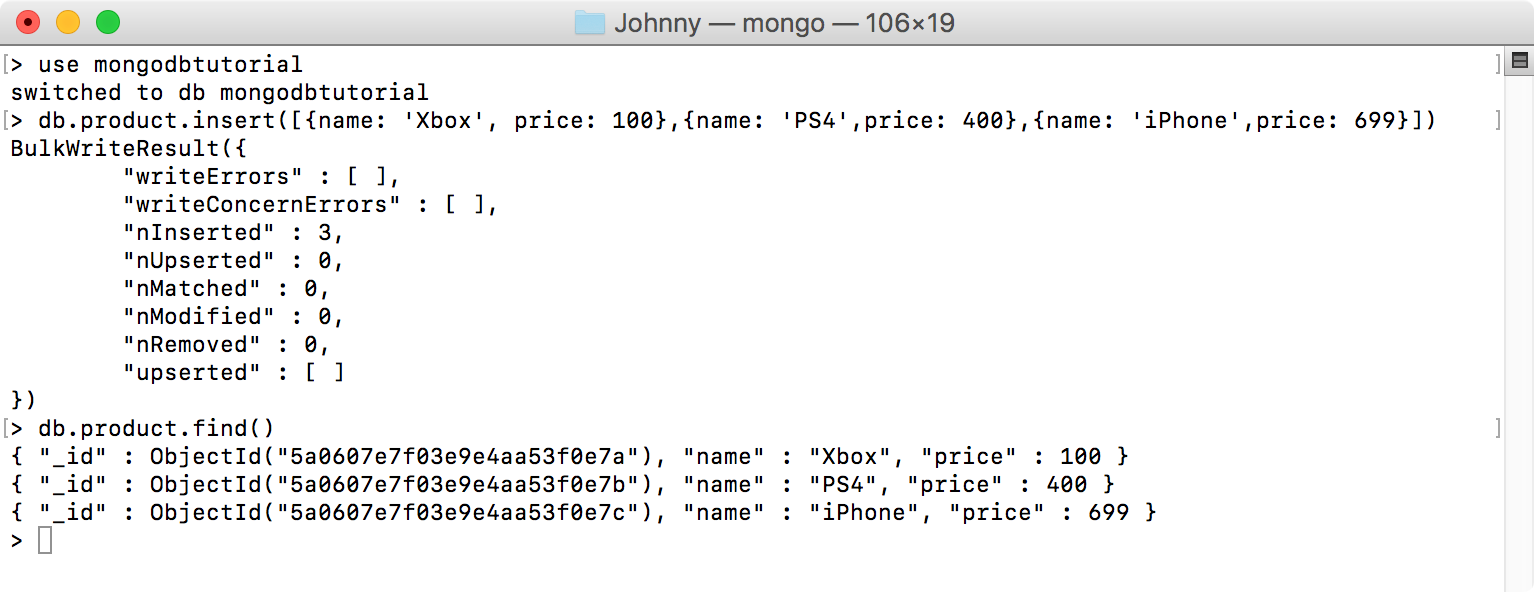
4. Testing
Launch the MongoDB Tutorial application, access http://localhost:8080/MongoDBTutorial/productlist.jsp in browser.
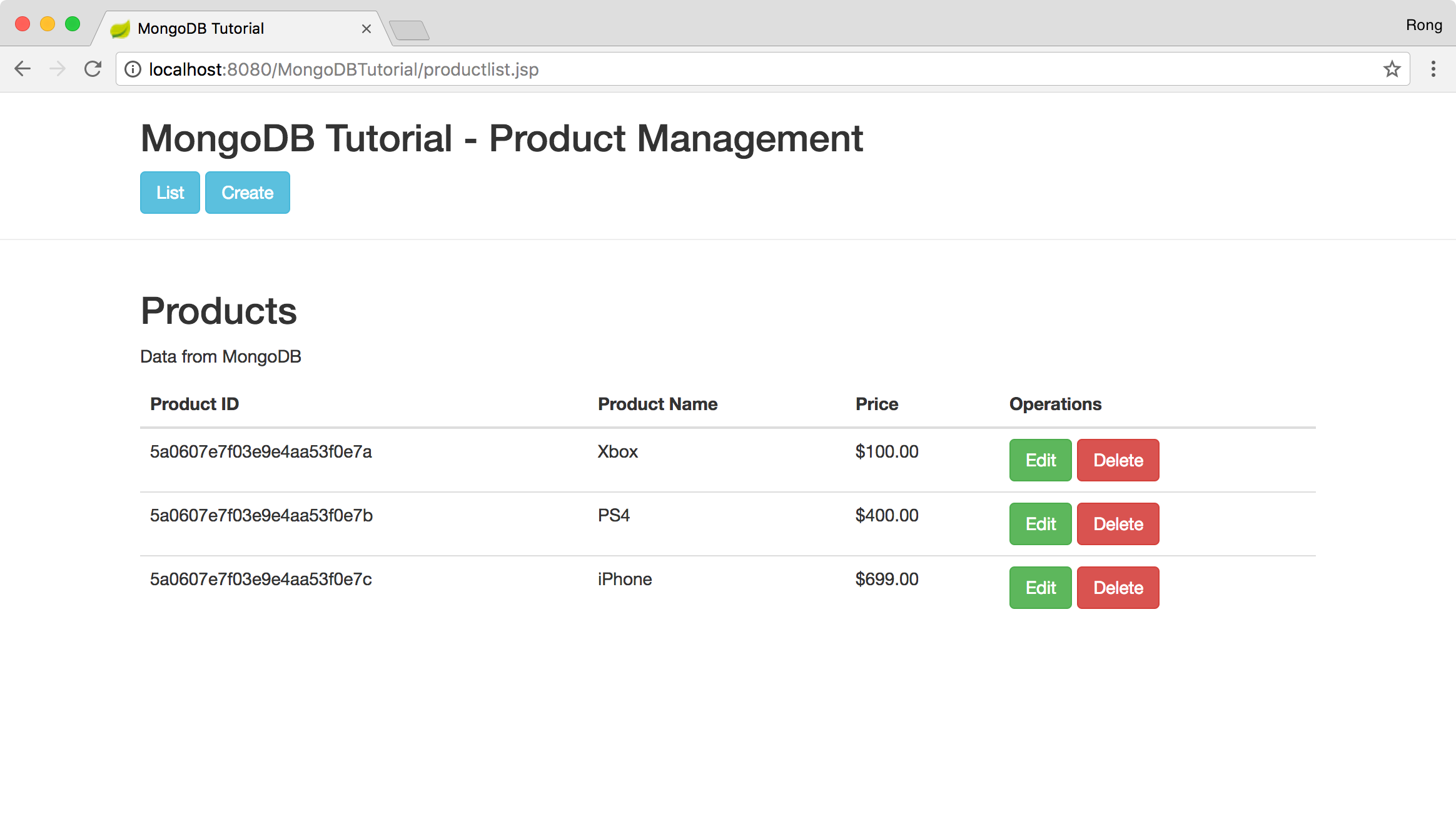 Click the ‘Create’ button, input product name and price.
Click the ‘Create’ button, input product name and price.
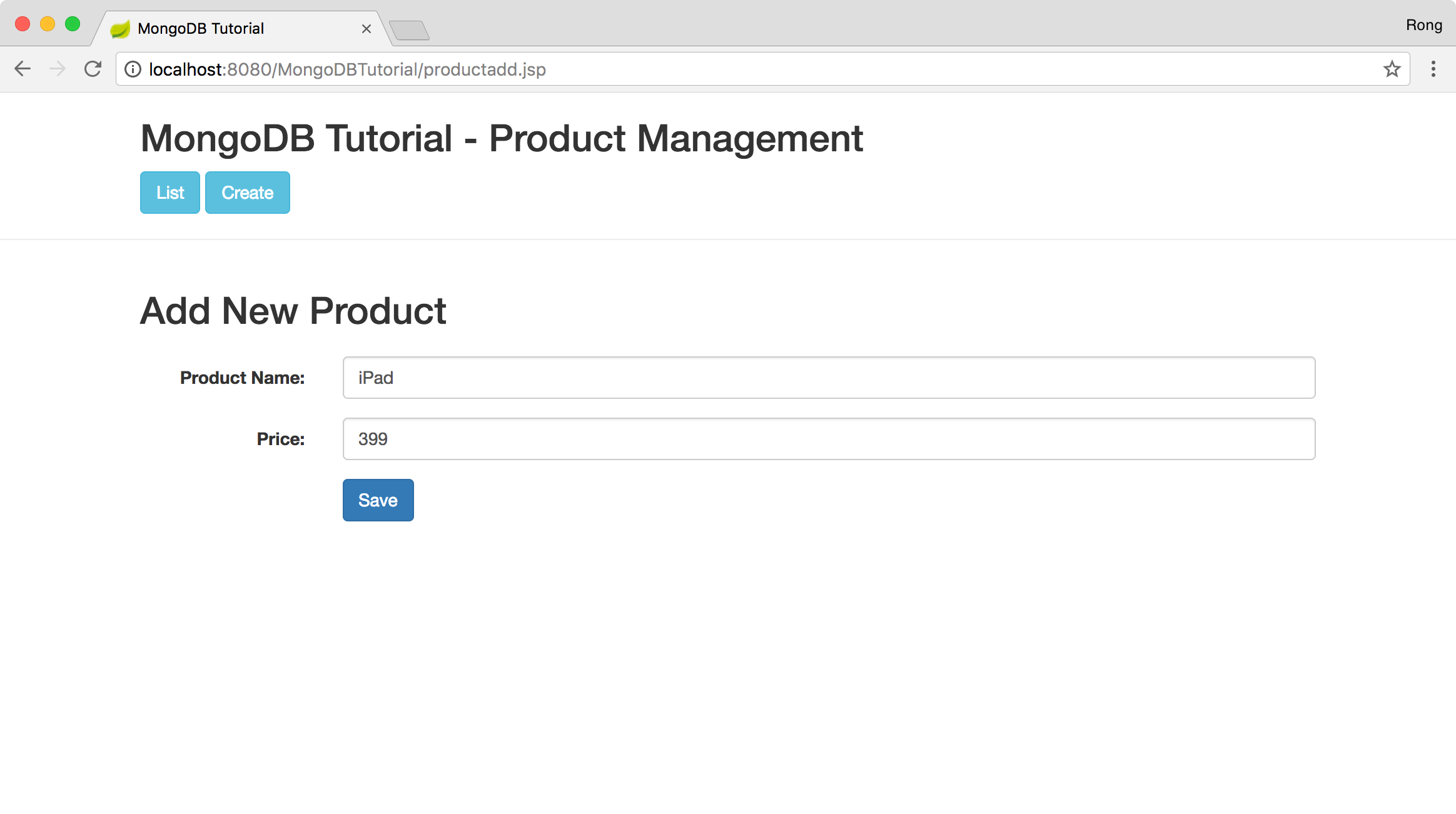 Click ‘Save’ button, product is saved.
Click ‘Save’ button, product is saved.
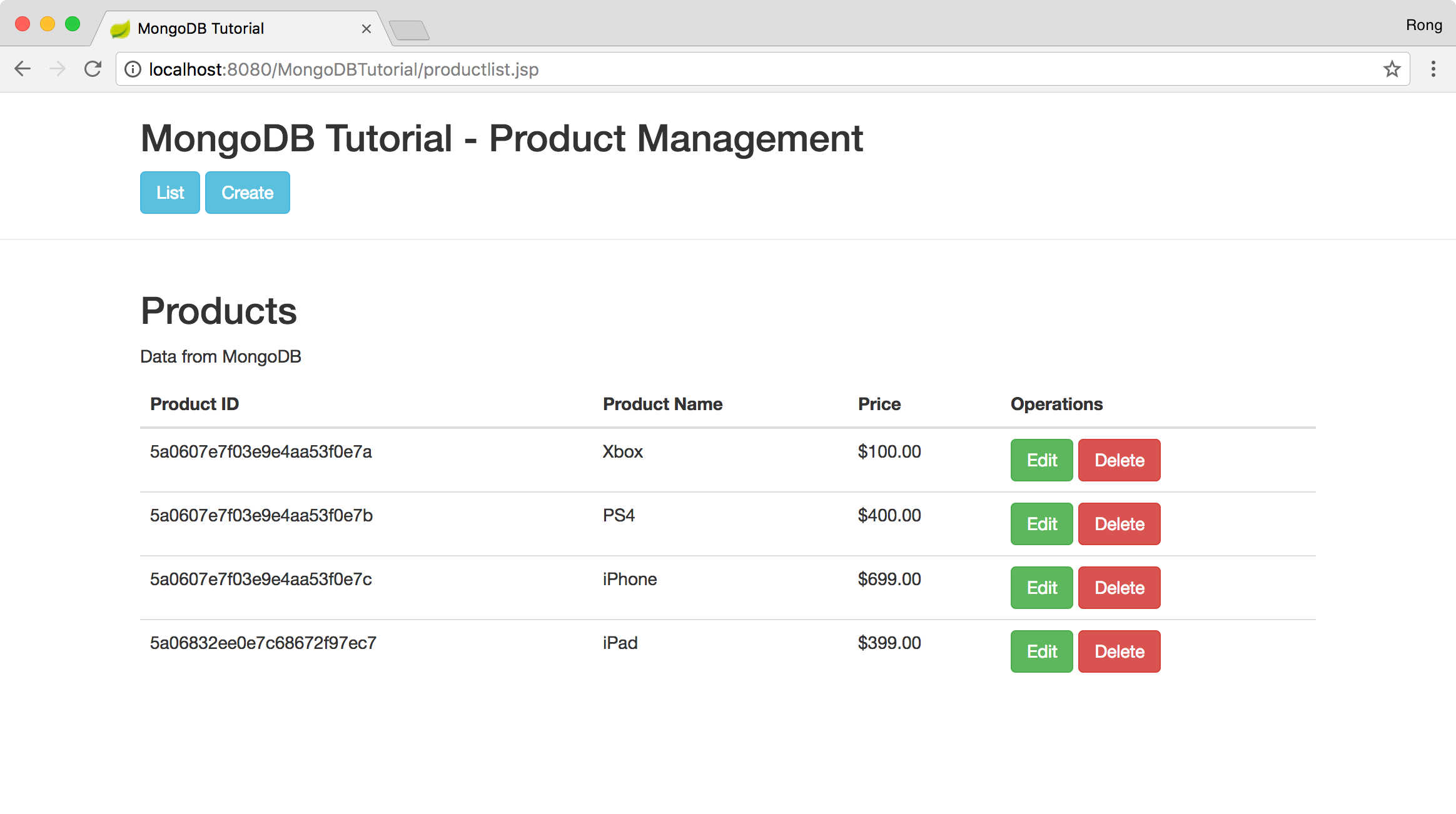 Click ‘Edit’ button of the new added product. Change the product name and price.
Click ‘Edit’ button of the new added product. Change the product name and price.
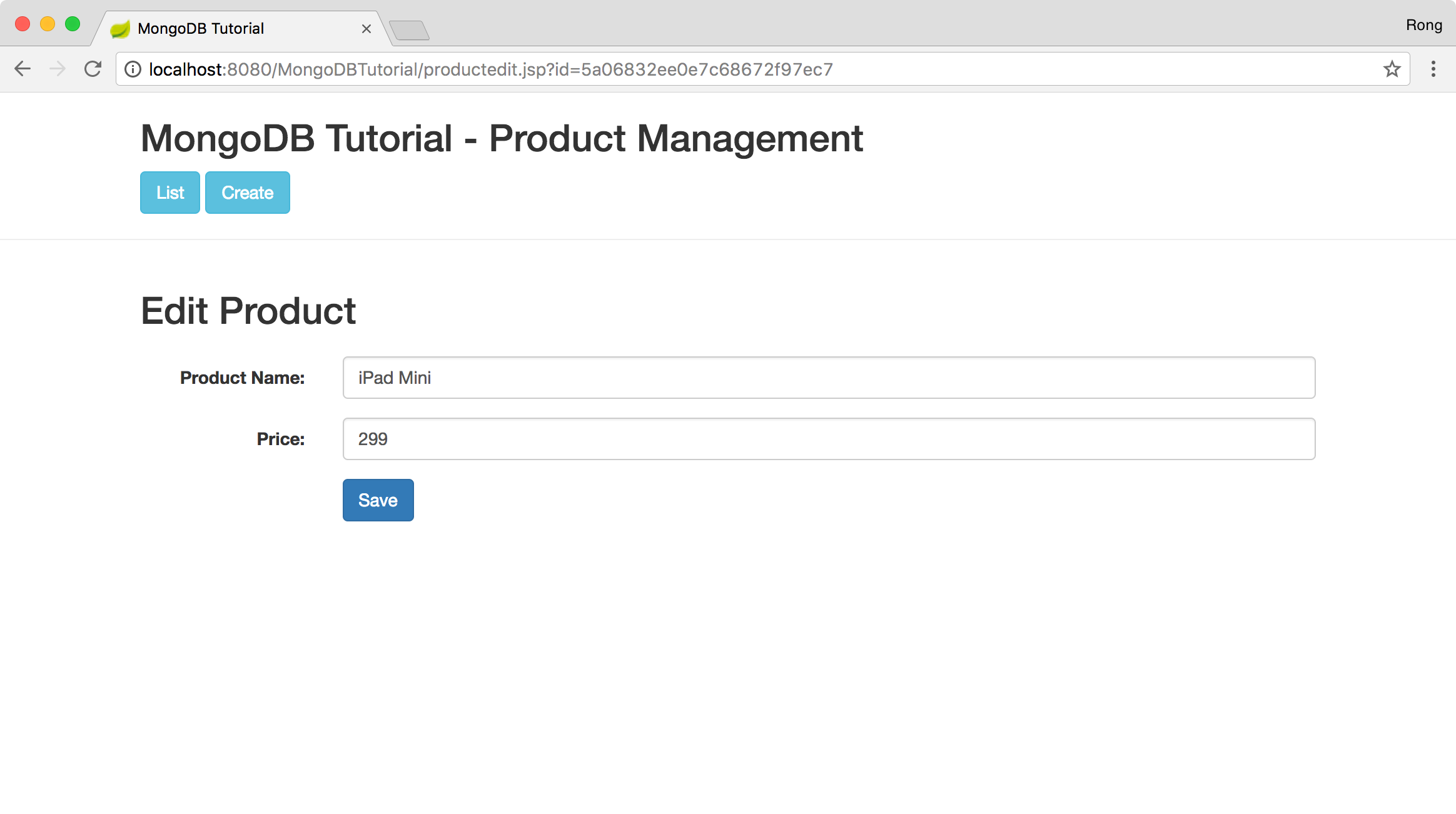 Click ‘Save’ button, product(ID=4) is updated.
Click ‘Save’ button, product(ID=4) is updated.
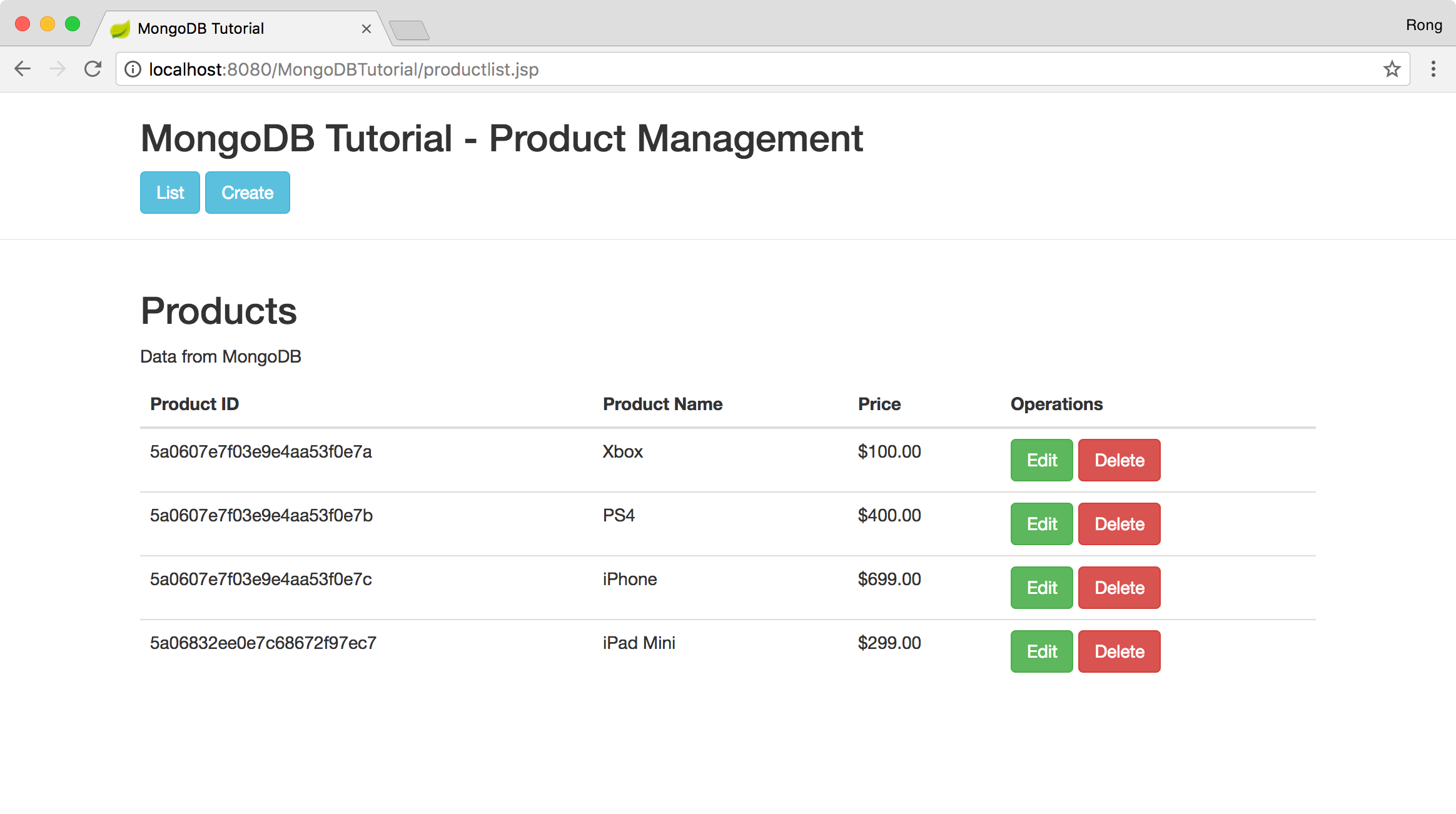 Click ‘Delete’ button of the last product. A popup window for confirming the delete operation shows up.
Click ‘Delete’ button of the last product. A popup window for confirming the delete operation shows up.
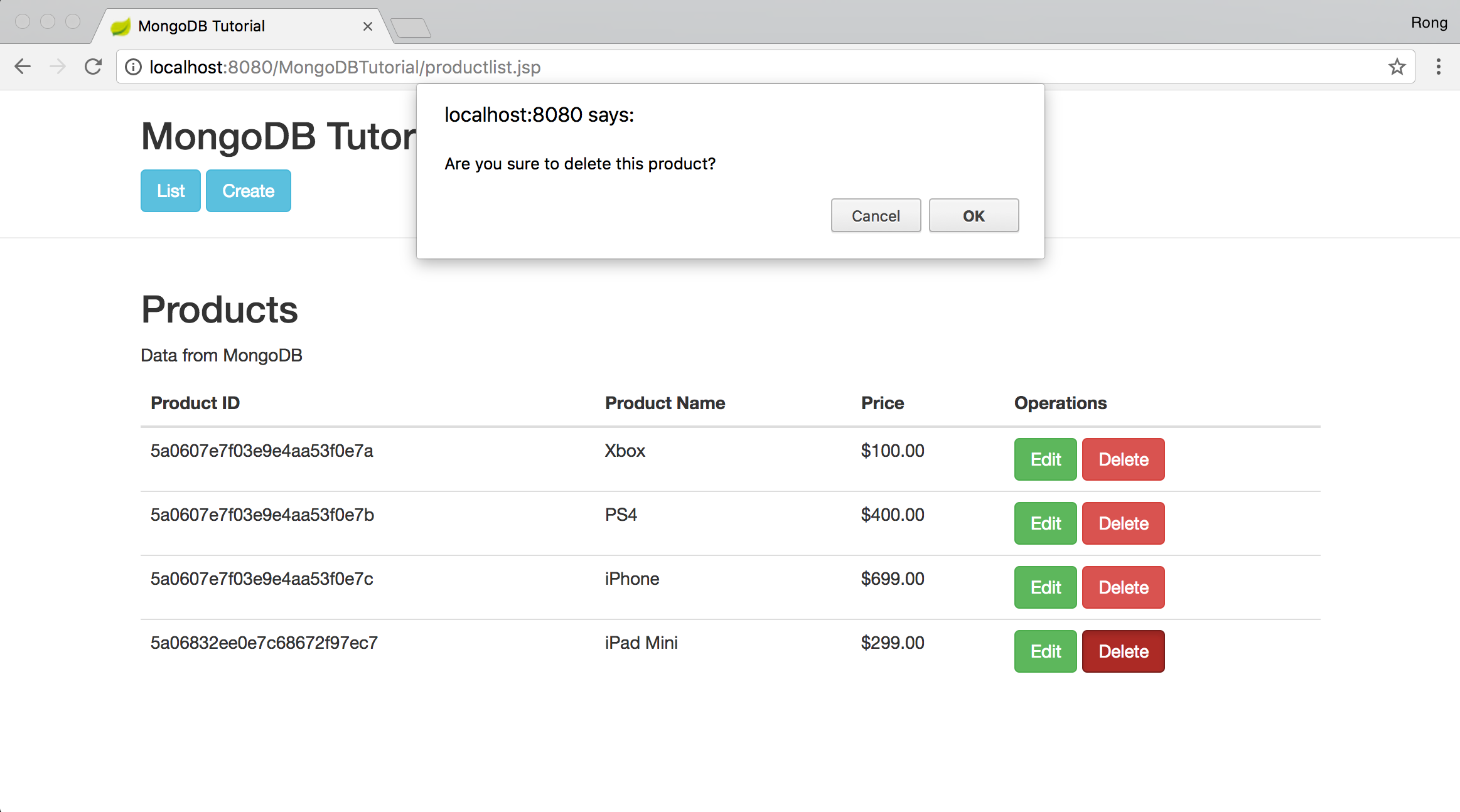 Click ‘OK’ button, product will be deleted.
Click ‘OK’ button, product will be deleted.
